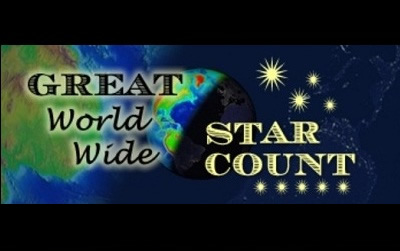 Okay, it's the fall version of the citizen science efforts to help quantify light pollution around the world, the Great World Wide Star Count. Participation is simple and requires nothing more than your eyes and a little knowledge. All you have to do is go outside after dark and observe an easy to find constellation (Cygnus if you live in the northern hemisphere, Sagitarius if you live in the southern hemisphere) and match what you see in the sky with one of their star charts. Once you have your data, you enter it along with your latitude, longitude, time and date of your observation and that's it. There is a handy link that will help you find your latitude and longitude based on your address or let you click on a map. You can use a GPS unit or your phone's GPS unit as well. Once you enter your data, you can see it on the results page.
Okay, it's the fall version of the citizen science efforts to help quantify light pollution around the world, the Great World Wide Star Count. Participation is simple and requires nothing more than your eyes and a little knowledge. All you have to do is go outside after dark and observe an easy to find constellation (Cygnus if you live in the northern hemisphere, Sagitarius if you live in the southern hemisphere) and match what you see in the sky with one of their star charts. Once you have your data, you enter it along with your latitude, longitude, time and date of your observation and that's it. There is a handy link that will help you find your latitude and longitude based on your address or let you click on a map. You can use a GPS unit or your phone's GPS unit as well. Once you enter your data, you can see it on the results page.If you go outside your house at make a measurement, that is great. However, you can make multiple measurements at different locations. If you go out to dinner or a movie, take a minute to look up. Don't worry if someone else has already taken a measurement at the same spot...multiple measurements are useful!
I have blogged on light pollution and its effects many times in the past. Light pollution is an big old energy waster since light going to space doesn't do much good for those of us on the ground. People who live near the oceans are familiar with the effects of light pollution on sea turtles. Here in Tucson there is a research project underway to study the effects of light pollution on bats and there are numerous studies underway investigating light pollution's effects on human health as well.
Now as I have mentioned before, the solution is not to turn out all the lights but to make sure we have well designed lighting. Well designed lighting puts light only where it is needed and when it is needed and only the minimum amount needed (too much light can increase glare and can create harsh shadows which reduces visibility). Groups such as the International Dark Sky Association have guides on well designed nighttime lighting.
Light pollution is one of those problems that can be solved with a little citizen involvement to foster awareness on the part of government and businesses when they replace their lights. The benefits include reduced energy consumption, a more natural nighttime environment for wildlife, and increased human health and safety. The first step it to gather data and build awareness which is a major goal of the Great Woldwide Star Count.Reprinted with permission from the Half-Astrophysicist Blog.





1 comment:
I did this the last time you posted. It was depressing to see how much I am missing...
Post a Comment